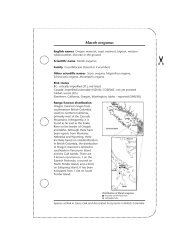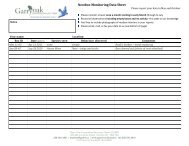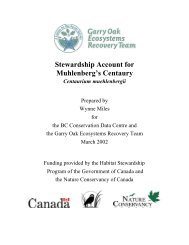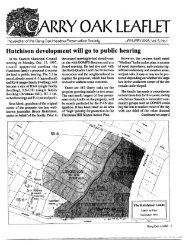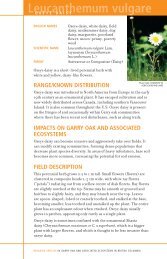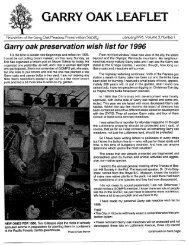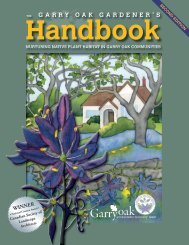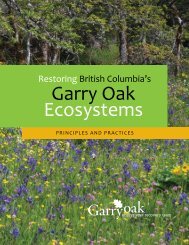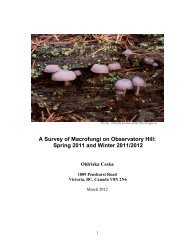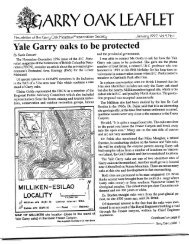PDF 320KB - Garry Oak Ecosystems Recovery Team
PDF 320KB - Garry Oak Ecosystems Recovery Team
PDF 320KB - Garry Oak Ecosystems Recovery Team
You also want an ePaper? Increase the reach of your titles
YUMPU automatically turns print PDFs into web optimized ePapers that Google loves.
DETECTING CHANGES IN GARRY OAK<br />
VEGETATION PLOTS AFTER 4 DECADES:<br />
FOLLOWING IN DR. HANS ROEMER’S FOOTSTEPS<br />
Jenny McCune<br />
University of British Columbia<br />
In order to understand how plant communities are changing in<br />
response to human disturbance, it is useful to have a historical<br />
baseline by which to measure changes. However, such baseline data<br />
are often unavailable for many regions and time periods. On the<br />
Saanich peninsula of Vancouver Island, Dr. Hans Roemer surveyed<br />
over four hundred 20m by 20m relevé plots in the late 1960s as part<br />
of his doctoral research. This provides a unique opportunity to<br />
quantify the changes in vegetation on the Peninsula in the past 40<br />
years. I used Dr. Roemer’s field notes to return to 184 of his plot<br />
locations, 43 of which were in <strong>Garry</strong> oak communities, and<br />
resurveyed them using the same methodology. Preliminary analyses<br />
show that herbaceous plant richness in <strong>Garry</strong> <strong>Oak</strong> plots increased<br />
significantly, from an average of 28.4 species to an average of 33.1<br />
species. The total number of herbaceous species found in <strong>Garry</strong> <strong>Oak</strong><br />
plots increased from 121 in 1968 to 139 in 2009. Exotic species<br />
represented approximately 20% of <strong>Garry</strong> <strong>Oak</strong> herbaceous flora in<br />
1968, increasing to 40% by 2009. I looked for changes in plant<br />
community composition by using Non-Metric Multidimensional<br />
Scaling to ordinate all plots in both years. There seems to have been a<br />
much larger shift in herbaceous plant composition in Douglas-firdominated<br />
communities compared to <strong>Garry</strong> oak-dominated plots. I<br />
hypothesize that this greater change in Douglas-fir-dominated<br />
herbaceous flora may be due to a larger degree of fragmentation of<br />
Douglas-fir forests between 1968 and 2009, whereas many <strong>Garry</strong> oak<br />
plots were located in fragments that have not changed in size since<br />
Dr. Roemer’s survey. Future work will aim to determine the<br />
relationship between vegetation changes and changes in the degree of<br />
human disturbance across the landscape. Using historical data is a<br />
valuable way to gain understanding of vegetation changes, and<br />
researchers today should consider making and keeping detailed notes<br />
on the locations and methodology of their projects in order to provide<br />
a baseline for ecologists of the future.<br />
<strong>Garry</strong> <strong>Oak</strong> <strong>Ecosystems</strong> <strong>Recovery</strong> <strong>Team</strong> – Research Colloquium 2010 Page 19




